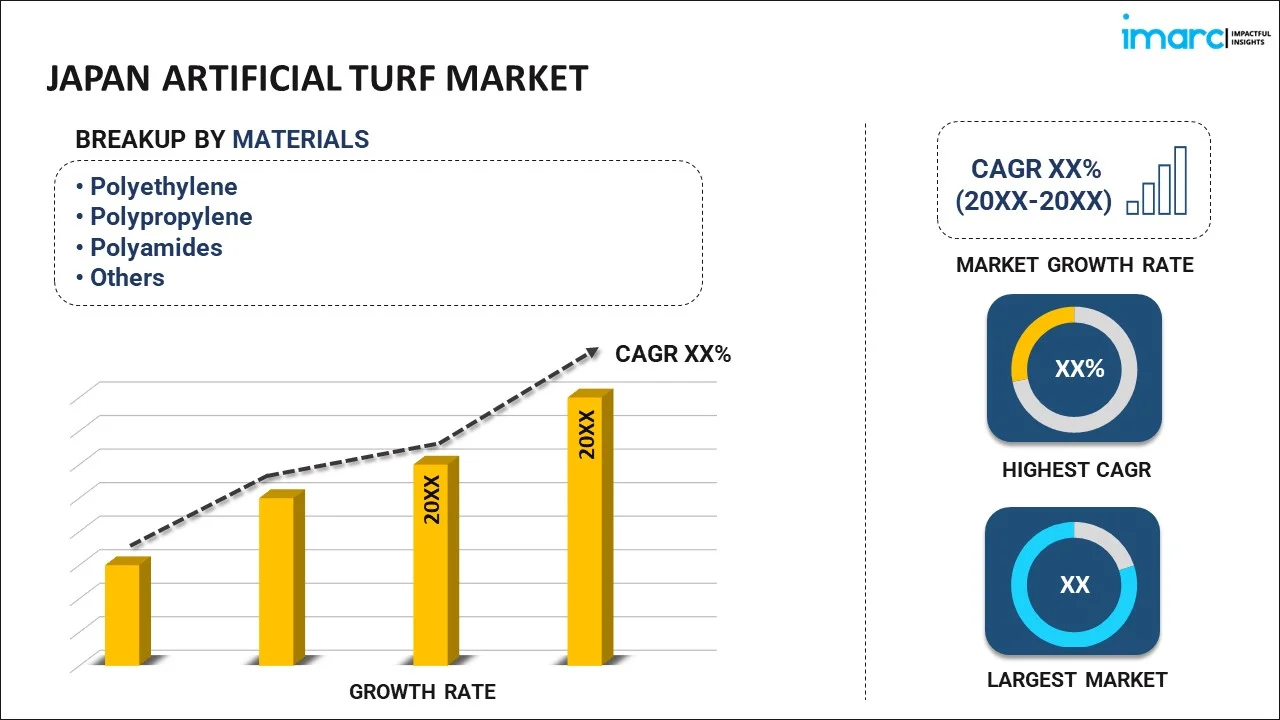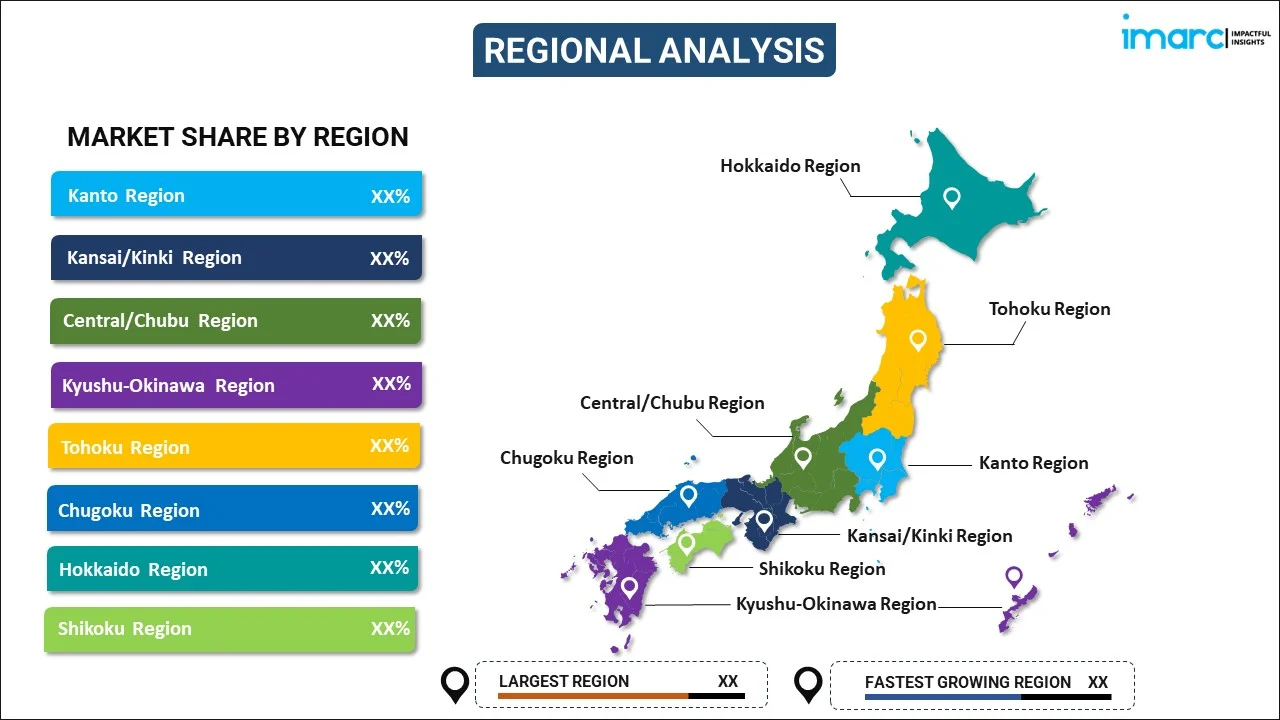
Japan Artificial Turf Market Report by Material (Polyethylene, Polypropylene, Polyamides, and Others), Application (Household, Sports and Leisure, Restaurant and Hotels, Airports and Commercial Offices, and Others), Distribution Channel (Direct Sales/B2B, Online Stores, Specialty Stores, Convenience Stores, and Others), and Region 2025-2033
Market Overview:
Japan artificial turf market size is projected to exhibit a growth rate (CAGR) of 9.4% during 2025-2033. The growing development of synthetic grass fibers that mimic the look and feel of natural grass, rising demand for sustainable and low-maintenance landscaping solutions, and increasing concerns about water scarcity among the masses represent some of the key factors driving the market.
|
Report Attribute
|
Key Statistics
|
|---|---|
|
Base Year
|
2024 |
|
Forecast Years
|
2025-2033 |
|
Historical Years
|
2019-2024
|
| Market Growth Rate (2025-2033) | 9.4% |
Artificial turf is a synthetic surface made from a blend of materials, typically including plastic, rubber, and other fibers. It comprises sports turf, which is designed to mimic the playing conditions of natural grass and can vary in thickness and performance characteristics. It also consists of landscape turf, which is ideal for residential and commercial landscaping. It includes playground turf, which is engineered to provide safety and cushioning, reducing the risk of injuries during play. It also encompasses putting green turf, which is crafted to replicate the look and feel of a golf course putting green, making it suitable for golf enthusiasts. It helps conserve water resources as it eliminates the need for regular watering. Artificial turf also reduces the need for time-consuming and costly maintenance tasks associated with natural grass. It contributes to a greener and more sustainable environment by reducing the use of lawnmowers, pesticides, and fertilizers. It is designed to withstand heavy use, making it an excellent choice for high-traffic areas. It can be used in all weather conditions, offering a consistent green surface throughout the year.
Japan Artificial Turf Market Trends:
At present, the escalating demand for sustainable and low-maintenance landscaping solutions that reduce the use of pesticides and fertilizers and mitigate the environmental impact of traditional grass lawns represents one of the crucial factors impelling the growth of the market in Japan. Besides this, rising concerns about water scarcity among the masses are driving the adoption of artificial turf as an eco-friendly alternative for living and outdoor spaces. Artificial turf offers a versatile landscaping option for these urban environments, enabling the creation of green spaces on rooftops, balconies, and other confined areas. Its adaptability to various surfaces and its low maintenance requirements make it an appealing choice for individuals and businesses looking to add a touch of green to urban landscapes. Furthermore, the growing awareness about the health and safety benefits of artificial turf in sports applications is contributing to the market growth in the country. Additionally, advancements in artificial turf technology are leading to the creation of softer and more shock-absorbent surfaces, further enhancing player safety. As a result, sports organizations, schools, and municipalities are increasingly opting for artificial turf installations to promote the well-being of athletes. Manufacturers are also investing in research and development (R&D) activities to create more realistic, sustainable, and eco-friendly turf products. This includes the development of synthetic grass fibers that mimic the look and feel of natural grass and improvements in texture to enhance turf performance in various weather conditions.
Japan Artificial Turf Market Segmentation:
IMARC Group provides an analysis of the key trends in each segment of the market, along with forecasts at the country level for 2025-2033. Our report has categorized the market based on material, application, and distribution channel.
Material Insights:

- Polyethylene
- Polypropylene
- Polyamides
- Others
The report has provided a detailed breakup and analysis of the market based on the material. This includes polyethylene, polypropylene, polyamides, and others.
Application Insights:
- Household
- Sports and Leisure
- Restaurant and Hotels
- Airports and Commercial Offices
- Others
A detailed breakup and analysis of the market based on the application have also been provided in the report. This includes household, sports and leisure, restaurant and hotels, airports and commercial offices, and others.
Distribution Channel Insights:
- Direct Sales/B2B
- Online Stores
- Specialty Stores
- Convenience Stores
- Others
The report has provided a detailed breakup and analysis of the market based on the distribution channel. This includes direct sales/B2B, online stores, specialty stores, convenience stores, and others.
Regional Insights:

- Kanto Region
- Kansai/Kinki Region
- Central/ Chubu Region
- Kyushu-Okinawa Region
- Tohoku Region
- Chugoku Region
- Hokkaido Region
- Shikoku Region
The report has also provided a comprehensive analysis of all the major regional markets, which include Kanto Region, Kansai/Kinki Region, Central/ Chubu Region, Kyushu-Okinawa Region, Tohoku Region, Chugoku Region, Hokkaido Region, and Shikoku Region.
Competitive Landscape:
The market research report has also provided a comprehensive analysis of the competitive landscape. Competitive analysis such as market structure, key player positioning, top winning strategies, competitive dashboard, and company evaluation quadrant has been covered in the report. Also, detailed profiles of all major companies have been provided.
Japan Artificial Turf Market Report Coverage:
| Report Features | Details |
|---|---|
| Base Year of the Analysis | 2024 |
| Historical Period | 2019-2024 |
| Forecast Period | 2025-2033 |
| Units | Million USD |
| Scope of the Report | Exploration of Historical Trends and Market Outlook, Industry Catalysts and Challenges, Segment-Wise Historical and Future Market Assessment:
|
| Materials Covered | Polyethylene, Polypropylene, Polyamides, Others |
| Applications Covered | Household, Sports and Leisure, Restaurant and Hotels, Airports and Commercial Offices, Others |
| Distribution Channels Covered | Direct Sales/B2B, Online Stores, Specialty Stores, Convenience Stores, Others |
| Regions Covered | Kanto Region, Kansai/Kinki Region, Central/ Chubu Region, Kyushu-Okinawa Region, Tohoku Region, Chugoku Region, Hokkaido Region, Shikoku Region |
| Customization Scope | 10% Free Customization |
| Post-Sale Analyst Support | 10-12 Weeks |
| Delivery Format | PDF and Excel through Email (We can also provide the editable version of the report in PPT/Word format on special request) |
Key Questions Answered in This Report:
- How has the Japan artificial turf market performed so far and how will it perform in the coming years?
- What has been the impact of COVID-19 on the Japan artificial turf market?
- What is the breakup of the Japan artificial turf market on the basis of material?
- What is the breakup of the Japan artificial turf market on the basis of application?
- What is the breakup of the Japan artificial turf market on the basis of distribution channel?
- What are the various stages in the value chain of the Japan artificial turf market?
- What are the key driving factors and challenges in the Japan artificial turf?
- What is the structure of the Japan artificial turf market and who are the key players?
- What is the degree of competition in the Japan artificial turf market?
Key Benefits for Stakeholders:
- IMARC’s industry report offers a comprehensive quantitative analysis of various market segments, historical and current market trends, market forecasts, and dynamics of the Japan artificial turf market from 2019-2033.
- The research report provides the latest information on the market drivers, challenges, and opportunities in the Japan artificial turf market.
- Porter's five forces analysis assist stakeholders in assessing the impact of new entrants, competitive rivalry, supplier power, buyer power, and the threat of substitution. It helps stakeholders to analyze the level of competition within the Japan artificial turf industry and its attractiveness.
- Competitive landscape allows stakeholders to understand their competitive environment and provides an insight into the current positions of key players in the market.
Need more help?
- Speak to our experienced analysts for insights on the current market scenarios.
- Include additional segments and countries to customize the report as per your requirement.
- Gain an unparalleled competitive advantage in your domain by understanding how to utilize the report and positively impacting your operations and revenue.
- For further assistance, please connect with our analysts.
 Inquire Before Buying
Inquire Before Buying
 Speak to an Analyst
Speak to an Analyst
 Request Brochure
Request Brochure
 Request Customization
Request Customization




.webp)




.webp)












